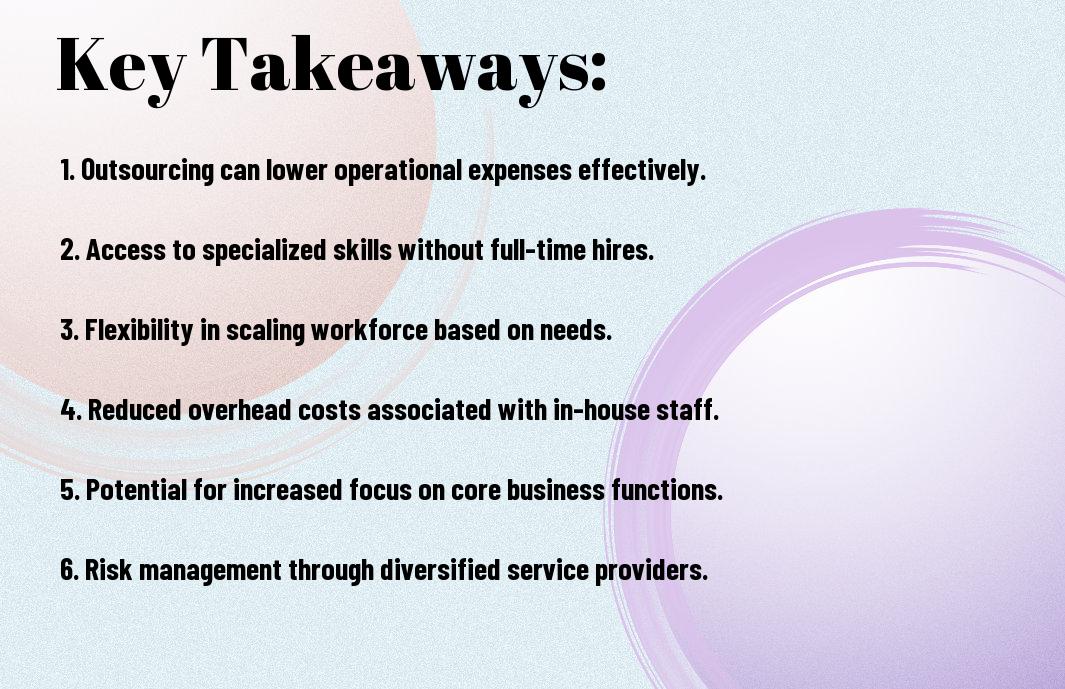Outsourcing key IT services can be a strategic move for your business, potentially leading to significant reductions in staff costs. By leveraging external expertise, you can focus your internal resources on core activities while gaining access to advanced technologies and skilled professionals. However, it’s vital to consider the potential risks, such as loss of control and data security concerns, which could outweigh the benefits. In this post, we’ll explore how you can take advantage of outsourcing while effectively managing its challenges, aiming for a balanced approach to operational efficiency.
Key Takeaways:
- Outsourcing IT services can lead to significant cost savings by reducing the need for in-house staff and associated expenses such as salaries, benefits, and training.
- Access to specialized skills and technologies through outsourcing allows companies to enhance their operational efficiency without the burden of long-term commitments to new hires.
- While outsourcing may lower immediate staffing costs, organizations should consider potential challenges such as communication barriers, loss of control, and alignment with company culture.

Understanding IT Outsourcing Fundamentals
The landscape of IT outsourcing has evolved significantly over the years, becoming an necessary strategy for businesses seeking to enhance operational efficiency and control costs. By leveraging external service providers, you can tap into specialized expertise and technology that might be too costly or complex to develop in-house. This approach allows you to focus your internal resources on core business functions while relying on experienced professionals to manage your IT needs. Understanding the various models available for outsourcing is fundamental to determining which option best fits your organizational goals and budget.
Defining IT Outsourcing Models
Beside the traditional outsourcing arrangements, there are several models that you can consider when outsourcing your IT services. These include full outsourcing, where you transfer responsibility for entire IT functions to an external provider, and co-sourcing, where you share responsibility for certain IT functions with a partner. There are also build-operate-transfer (BOT) models that allow you to create a dedicated team in a different location, which can be gradually transitioned to your ownership. Understanding these models can help you evaluate which structure aligns best with your operational strategies and long-term objectives.
Current Market Trends in IT Outsourcing
Trends indicate a notable shift in how organizations approach IT outsourcing, highlighting a growing preference for flexible, scalable solutions tailored to dynamic business environments. Many companies are moving towards multi-vendor strategies, which allow you to spread risk and leverage different areas of expertise based on project needs. Additionally, the rise of remote work has accelerated the adoption of digital collaboration tools, enabling teams to function effectively regardless of their physical location. This adaptability not only supports cost efficiency but also enhances workforce productivity.
Further examination of current market trends reveals that businesses are increasingly prioritizing cybersecurity and data privacy within their outsourcing strategies. As cyber threats continue to evolve, you must ensure that your outsourced IT partners adhere to strict security protocols to safeguard sensitive information. Additionally, the demand for cloud computing solutions is rising as firms seek to improve data access and integration capabilities. Staying informed about these trends equips you with the knowledge to make strategic decisions that will benefit your organization’s performance and bottom line.


Cost Analysis of In-House vs. Outsourced IT
Any business owner considering their IT service options will quickly realize that the choice between hiring in-house staff or outsourcing these functions can have significant financial implications. When analyzing direct staff costs, it’s important to break down every expense associated with staffing in-house versus leveraging an outsourced service provider. The table below illustrates some key factors in your cost comparison.
| Cost Factors | In-House IT | Outsourced IT |
|---|---|---|
| Base Salaries | High | Varies (often lower) |
| Benefits & Bonuses | High | Minimal (contractual) |
| Training & Development | Ongoing costs | Included in service agreements |
| Office Space & Resources | Required | Not applicable |
Direct Staff Cost Comparison
An in-house IT workforce can seem extensive due to salaries, benefits, and the resources necessary to maintain their productivity. In contrast, outsourcing can substantially lower these direct costs. By contracting specialized firms, you can enjoy the expertise of a full staff without the additional expenses associated with maintaining a permanent workforce. You’ll often find that outsourced providers can deliver the same quality of service at a fraction of the cost, allowing you to allocate funds more effectively.
Hidden Expenses and Overhead Considerations
Around the direct costs of staffing, you should also account for various hidden expenses that can inflate the overall financial burden of in-house IT teams. These can include costs related to equipment, software licenses, utilities, and training sessions that may not be immediately apparent. Additionally, your ongoing managerial resources related to hiring, onboarding, and supervising IT personnel add to the overhead.
The assessment of hidden expenses can lead to a more comprehensive understanding of total costs. Operational inefficiencies may also arise from a lack of specialized knowledge internally, leading to potential lost productivity. Engaging an outsourced IT provider often results in a net reduction of costs, as you can focus on optimizing your operations while they handle the technical aspects. This approach not only saves money but can also foster a more innovative and agile approach to your business needs.
Benefits Beyond Cost Reduction
Not only does outsourcing IT services help in reducing your staff costs, but it also brings a myriad of other benefits that can enhance your business operations. You can tap into specialized expertise that might not be available within your current team, allowing for improved service delivery and innovation. Additionally, outsourcing provides you with the ability to delegate routine tasks to external providers, freeing up your internal staff to focus on strategic initiatives that are core to your business growth.
Access to Global Talent Pool
Reduction in geographical limitations is one of the significant benefits of outsourcing IT services. By going global, you can access a vast pool of highly skilled professionals who specialize in various IT domains. This access means you can find the right talent that closely aligns with your project requirements without being restricted by local constraints. Furthermore, engaging with diverse teams can lead to innovative solutions and fresh perspectives that enhance your company’s competitive edge.
Scalability and Flexibility Advantages
Between the demands of an ever-evolving market and unexpected project needs, you must have a setup that allows for scalability and flexibility. Outsourcing enables you to scale your IT operations up or down based on your immediate business requirements. You can easily adjust your resource allocation without the long-term commitment that hiring additional full-time staff entails, ensuring that your business remains agile and responsive.
At the heart of scalability is the ability to meet your business needs without the headache of long-term contracts or employee overhead costs. This flexibility lets you augment your workforce during peak times and downsize during quieter periods, making it easier for you to manage budgets effectively. Additionally, partnering with a reliable outsourcing provider means you can quickly access the latest technologies and innovations without incurring large capital expenditures, which significantly enhances your operational efficiency.
Potential Risks and Challenges
Once again, while outsourcing IT services can lead to substantial reductions in staff costs, it is crucial to also consider the potential risks and challenges associated with this decision. You may find that relying on external providers can create dependencies that leave your organization vulnerable. This can impact your control over service delivery, requiring your team to spend additional time and resources managing these external relationships. Additionally, transitioning services can lead to disruptions in operations if not handled properly, ultimately affecting productivity and service quality.
Quality Control and Communication
An effective outsourcing strategy hinges on your ability to maintain quality control and ensure seamless communication with your chosen provider. You may encounter challenges in aligning expectations, particularly if there is a lack of clear communication channels. Misunderstandings could lead to costly mistakes that not only hinder quality but could also affect your overall business goals. To mitigate these risks, it is crucial to establish detailed performance metrics and regular check-ins that foster productive dialogue between your team and the service provider.
Data Security and Compliance Issues
Before you decide to outsource IT functions, you must evaluate how this move could impact your organization’s data security and compliance. Depending on the nature of your work, outsourcing could expose sensitive information to third-party risks, increasing your vulnerability to data breaches. Regulatory compliance might also become complex, especially if your providers are located in different jurisdictions with varying laws and requirements. It is vital to conduct thorough due diligence on potential partners and ensure they have robust security measures in place that align with your compliance standards.
In addition, you should be aware that the transfer of data to an external provider can further complicate compliance efforts. You might face challenges related to ensuring that all outsourced processes comply with regulations like GDPR or HIPAA. Maintaining *strong* oversight and engaging with providers who have a proven track record in safeguarding data will help protect your interests while outsourcing. Allocating resources toward regular audits and risk assessments can also help you navigate these complex compliance landscapes effectively.
Implementation Strategies
Your approach to outsourcing IT services requires careful planning and execution to ensure that the transition is smooth and aligns with your business objectives. One of the key aspects of a successful outsourcing strategy is selecting the right outsourcing partner. You’ll want to focus on a partner who not only has proven expertise in the technology areas relevant to your needs but also demonstrates a consistent track record of reliability and support. Look for qualifications such as industry experience, client testimonials, and responsive communication—these factors can significantly influence the overall success of your outsourcing initiative.
Selecting the Right Outsourcing Partner
Above all, you must assess the cultural fit and compatibility between your organization and the outsourcing partner. A partner that understands your business values, communication style, and operational goals will likely integrate more seamlessly into your existing workflows. Evaluate potential partners through interviews, case studies, and pilot projects to gauge how they handle challenges and adapt to change. This due diligence will mitigate risks and enhance the partnership’s overall effectiveness.
Transition Planning and Management
Among the most important aspects of outsourcing is effective transition planning and management. This stage involves outlining clear expectations, defining roles and responsibilities, and establishing guidelines for communication between your team and the outsourcing partner. A structured transition plan will facilitate knowledge transfer and help maintain continuity in IT services during the shift. The last thing you want is to hinder your organization’s productivity while you’re adjusting to a new setup.
To ensure successful transition planning and management, focus on creating a comprehensive roadmap that addresses potential challenges and outlines action steps for both parties. Include detailed timelines, performance indicators, and contingency plans in your transition strategy. Pay attention to the employee sentiment regarding the change, as their support or resistance can affect productivity levels significantly. By fostering open communication and setting expectations from the outset, you can create a collaborative environment where both your internal team and outsourcing partner can thrive, ultimately paving the way for a successful outsourcing journey.
Measuring Success and ROI
All businesses looking to outsource IT services need a way to measure the effectiveness of this strategy. By implementing reliable key performance indicators (KPIs), you can track the performance of your outsourced services and ensure that they align with your overarching business goals. You should focus on KPIs such as the cost savings achieved, improvement in service levels, and the impact on project delivery times. Evaluating these metrics regularly allows you to assess if your partnership with an outsourcing provider is yielding the desired results and helps in making data-driven decisions for further investments.
Key Performance Indicators
About KPIs provide a tangible way for you to measure your outsourcing success. When you analyze performance against these indicators, you can more easily identify areas of improvement or success. In particular, metrics like customer satisfaction scores, the number of successfully completed projects, and response times for IT issues can offer significant insights. These KPIs not only inform you about the performance of your outsourced services but also give clarity on how those services integrate with your team and overall operations.
Long-term Financial Impact Assessment
Between evaluating immediate cost savings and potential long-term benefits, you should engage in a thorough financial impact assessment of your IT outsourcing strategy. This assessment should take into account the total cost of ownership, including any hidden costs associated with management, communication, and adjustments that the outsourcing relationship may entail. Understanding these financial dynamics will enable you to compare the ongoing costs versus the benefits over time, thus allowing you to determine whether the outsourcing approach will provide value in the long run.
In fact, the long-term financial impact assessment needs to cover aspects that often go unnoticed. These can include increases in productivity from your core team as they focus more on strategic activities rather than IT issues, a better return on investment (ROI) from cutting-edge technology provided by your outsourcing partner, and enhanced flexibility and scalability that can adapt to fluctuations in your business requirements. By fully grasping these implications, you can make a more informed decision about whether outsourcing IT services is indeed the right pathway for your organization in terms of cost-effectiveness and long-term benefits.
Conclusion
From above, it is clear that outsourcing IT services can offer significant financial advantages for your organization. By delegating IT functions to specialized firms, you can substantially reduce payroll expenses, as you do not have to maintain a full-time, in-house IT team. This approach allows you to allocate your resources more efficiently, focusing on core business activities while benefiting from expert support in technology management. Additionally, by leveraging outsourcing, you gain access to the latest technologies and skilled professionals without the overhead costs associated with keeping these resources in-house.
However, as you consider outsourcing, it is important to weigh the potential pitfalls against the benefits. Effective communication, alignment of expectations, and the choice of reliable partners are key considerations. It is advisable to conduct thorough research and due diligence to ensure that the outsourcing arrangement meets your organizational needs. Overall, if executed properly, outsourcing IT services can be an effective strategy for reducing staff costs while enhancing operational efficiency and technological capabilities within your business landscape.
Q: What are the main benefits of outsourcing IT services to reduce staff costs?
A: Outsourcing IT services can bring several benefits that contribute to reducing staff costs. One of the primary advantages is the ability to tap into specialized skills without the overhead associated with hiring full-time employees. This means companies can access expertise in areas like cybersecurity, cloud computing, and software development without the expenses tied to salaries, benefits, and training. Additionally, outsourcing provides flexibility; businesses can scale their IT resources up or down based on demand, which helps to avoid the costs of maintaining a large, permanent staff. Lastly, outsourcing can streamline operations, allowing internal teams to focus on core business functions, which can lead to increased productivity and cost savings overall.
Q: Are there potential hidden costs associated with outsourcing IT services?
A: Yes, while outsourcing IT services can lead to reduced direct staff costs, companies should be aware of potential hidden costs. These may include transition costs when onboarding external providers, as well as ongoing management expenses associated with overseeing the outsourced team. There can also be risks related to data security and compliance, which might necessitate additional investments in security measures and oversight. Communication challenges may arise, particularly if the outsourcing partner operates in a different time zone or culture, potentially leading to project delays or misunderstandings. Therefore, it’s important for businesses to thoroughly evaluate and plan for these potential costs to assess the overall financial impact of outsourcing.
Q: How can a company effectively manage an outsourced IT service provider to ensure cost reduction?
A: Effective management of an outsourced IT service provider is key to achieving cost reduction while maintaining quality and performance. First, establishing clear objectives and expectations from the start is important; this includes defining the scope of work, deliverables, and service level agreements (SLAs) that detail performance metrics. Regular communication and transparent reporting can help ensure that both parties remain aligned regarding goals and progress. It’s also beneficial to foster a collaborative relationship, allowing the outsourced team to understand the company’s unique challenges and culture fully. Finally, conducting periodic evaluations of the partnership can help identify areas for improvement and innovation, ensuring that the arrangement remains cost-effective and valuable over time.
